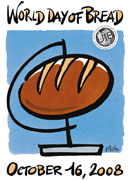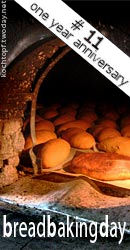
All my efforts are dedicated to Barbara and to her A Taste of Yellow – LiveStrong event: Thank you Barbara, for you bravery, your perseverance and for many things I’m just not able to put into words (especially English words!)
I have to admit that my first challenge with the Daring Bakers has blown gently for nearly an entire month in my kitchen, as an "aria" from my beloved Turandot, since I discovered which was the recipe I was supposed to bake…
I printed carefully the recipe and the rules and pinned both in my kitchen and then passed days and days speaking nothing but Opéra Cake (and I really appreciate your patience, my dear husband): trying to figure out how to prepare buttercream, flavour syrup and mousse, bake joconde and spread glaze (and I appreciate your “What’s?” and “Aha, indeed”, my dear husband, even if I suspect a hint, just a hint, of lack of attention)… and thinking perhaps I had dared too much, enrolling myself for the Daring Bakers Community (and thank you sooo much for your supportive “All this butter in a single recipe?!" and "13-I say-13 eggs!??!”, my dear etc…)!
I’ve never done before a buttercream, so my first attempt was a plain one, no flavour except vanilla. It came out well, indeed, but a little too buttery for my family (and for me, too, I have to admit)… so I went through another recipe, with egg withes instead, but it simply didn’t work: the cream separated and become grainy… perhaps because of the diced strawberries I put in…
So, nearly in panic now, I returned to the original recipe (in the meantime changed by the hosts in a less buttery one, which I really prefer…), with the hot syrup made with strawberry juice instead of water and, finally, it turns out beautifully!!!! At last the way was mapped out: I had decided for a strawberry flavoured Opéra Cake!
I prepared beforehand the buttercream (a week before, then frozen), the syrup (a week before, kept covered in the fridge), the day before I made mousse and joconde and all it turned out very well (I think that a nice stay in the fridge helps mousse and buttercream to set), even if my assembling really needs some practice!
I brought the cake to a dinner with my colleagues and it has been a successful “prima”, with a standing ovation for the orchestra…
And even my dear husband appreciate the Opéra Cake… even with "all-this- butter" and "13-I say-13 eggs"... (but I want to stress that the recipe claims 20 servings!!!)
So I’m very proud to introduce you, for the first time in this kitchen:
Almond Joconde
Strawberry syrup
Strawberry buttercream
Mousse au chocolat blanc
White chocolate glaze.
(Not a “daring” choice of flavours, I agreed, but for my first Opéra, I thought best stay with the Classics!!! Ah, and the recipe has been a happy choice of
Fran and
Shea and
Lis and
Ivonne: thank you, dear: I never have attempt on such a challenge without your spur).
And now… musica!
A Taste of Light: Opéra Cake
This recipe is based on Opéra Cake recipes in Dorie Greenspan’s Paris Sweets and Tish Boyle and Timothy Moriarty’s Chocolate Passion.
For the joconde
(Note: The joconde can be made up to 1 day in advance and kept wrapped at room temperate)
Ingredients:
6 large egg whites, at room temperature
2 tbsp. granulated sugar
2 cups ground blanched almonds
2 cups icing sugar, sifted
6 large eggs
½ cup all-purpose flour
3 tbsp. (1½ ounces) unsalted butter, melted and cooled
1.Divide the oven into thirds by positioning a rack in the upper third of the oven and the lower third of the oven.
2.Preheat the oven to 425◦F. (220◦C).
3.Line two 12½ x 15½- inch (31 x 39-cm) jelly-roll pans with parchment paper and brush with melted butter.
4.In the bowl of a stand mixer fitted with the whisk attachment (or using a handheld mixer), beat the egg whites until they form soft peaks. Add the granulated sugar and beat until the peaks are stiff and glossy. If you do not have another mixer bowl, gently scrape the meringue into another bowl and set aside.
5.If you only have one bowl, wash it after removing the egg whites or if you have a second bowl, use that one. Attach the paddle attachment to the stand mixer (or using a handheld mixer again) and beat the almonds, icing sugar and eggs on medium speed until light and voluminous, about 3 minutes.
6.Add the flour and beat on low speed until the flour is just combined (be very careful not to overmix here!!!).
7.Using a rubber spatula, gently fold the meringue into the almond mixture and then fold in the melted butter. Divide the batter between the pans and spread it evenly to cover the entire surface of each pan.
8.Bake the cake layers until they are lightly browned and just springy to the touch. This could take anywhere from 5 to 9 minutes depending on your oven. Place one jelly-roll pan in the middle of the oven and the second jelly-roll pan in the bottom third of the oven.9.Put the pans on a heatproof counter and run a sharp knife along the edges of the cake to loosen it from the pan. Cover each with a sheet of parchment or wax paper, turn the pans over, and unmold. 10.Carefully peel away the parchment, then turn the parchment over and use it to cover the cakes. Let the cakes cool to room temperature.
For the syrup
(Note: The syrup can be made up to 1 week in advance and kept covered in the refrigerator.)
Ingredients:
½ cup water
⅓ cup granulated sugar
1 to 2 tbsp. of the flavouring of your choice (i.e., vanilla extract, almond extract, cognac, limoncello, coconut cream, honey etc.)
1.Stir all the syrup ingredients together in the saucepan and bring to a boil.
2.Remove from the heat and let cool to room temperature.
For the buttercream
(Note: The buttercream can be made up to 1 month in advance and packed in an airtight container. If made way in advance, you can freeze the buttercream. Alternatively you can refrigerate it for up to 4 days after making it. To use the buttercream simply bring it to room temperature and then beat it briefly to restore its consistency.)
What you’ll need: a candy or instant-read thermometer
Ingredients:
1 cup granulated sugar
¼ cup water seeds of one vanilla bean (split a vanilla bean down the middle and scrape out the seeds) or 1 tbsp. pure vanilla extract (Note: If you are flavouring your buttercream and do not want to use the vanilla, you do not have to. Vanilla will often enhance other flavours but if you want an intense, one-flavoured buttercream, then by all means leave it out!)
1 large egg
1 large egg yolk
1¾ sticks unsalted butter, at room temperature
flavouring of your choice (a tablespoon of an extract, a few tablespoons of melted white chocolate, citrus zest, etc.)
1.Combine the sugar, water and vanilla bean seeds or extract in a small saucepan and warm over medium heat just until the sugar dissolves.
2.Continue to cook, without stirring, until the syrup reaches 225◦F (107◦C) [*Note: Original recipe indicates a temperature of 255◦F (124◦C), however, when testing the recipe I found that this was too high so we heated to 225◦F and it worked fine] on a candy or instant-read thermometer. Once it reaches that temperature, remove the syrup from the heat.
3.While the syrup is heating, begin whisking the egg and egg yolk at high speed in the bowl of your mixer using the whisk attachment. Whisk them until they are pale and foamy.
4.When the sugar syrup reaches the correct temperature and you remove it from the heat, reduce the mixer speed to low speed and begin slowly (very slowly) pouring the syrup down the side of the bowl being very careful not to splatter the syrup into the path of the whisk attachment. Some of the syrup will spin onto the sides of the bowl but don’t worry about this and don’t try to stir it into the mixture as it will harden!
5.Raise the speed to medium-high and continue beating until the eggs are thick and satiny and the mixture is cool to the touch (about 5 minutes or so).
6.While the egg mixture is beating, place the softened butter in a bowl and mash it with a spatula until you have a soft creamy mass.
7.With the mixer on medium speed, begin adding in two-tablespoon chunks. When all the butter has been incorporated, raise the mixer speed to high and beat until the buttercream is thick and shiny.
8.At this point add in your flavouring and beat for an additional minute or so.
9.Refrigerate the buttercream, stirring it often, until it’s set enough (firm enough) to spread when topped with a layer of cake (about 20 minutes).
For the white chocolate ganache/mousse
(Note: The mousse can be made ahead and refrigerated until you’re ready to use it.)
Ingredients:
7 ounces white chocolate1 cup plus
3 tbsp. heavy cream (35% cream)
1 tbsp. liquer of your choice (Bailey’s, Amaretto, etc.)
1.Melt the white chocolate and the 3 tbsp. of heavy cream in a small saucepan.
2.Stir to ensure that it’s smooth and that the chocolate is melted. Add the tablespoon of liqueur to the chocolate and stir. Set aside to cool completely.
3.In the bowl of a stand mixer, whip the remaining 1 cup of heavy cream until soft peaks form.
4.Gently fold the whipped cream into the cooled chocolate to form a mousse.
5.If it’s too thin, refrigerate it for a bit until it’s spreadable.
6.If you’re not going to use it right away, refrigerate until you’re ready to use.
For the glaze
(Note: It’s best to make the glaze right when you’re ready to finish the cake.)
Ingredients:
14 ounces white chocolate, coarsely chopped
½ cup heavy cream (35% cream)
1.Melt the white chocolate with the heavy cream. Whisk the mixture gently until smooth.
2.Let cool for 10 minutes and then pour over the chilled cake. Using a long metal cake spatula, smooth out into an even layer.
3.Place the cake into the refrigerator for 30 minutes to set.
Assembling the Opéra Cake
Line a baking sheet with parchment or wax paper.
Working with one sheet of cake at a time, cut and trim each sheet so that you have two pieces (from each cake so you’ll have four pieces in total): one 10-inch (25-cm) square and one 10 x 5-inch (25 x 12½-cm) rectangle.
Place one square of cake on the baking sheet and moisten it gently with the flavoured syrup.
Spread about three-quarters of the buttercream over this layer.
Top with the two rectangular pieces of cake, placing them side by side to form a square. Moisten these pieces with the flavoured syrup.
Spread the remaining buttercream on the cake and then top with the third square of joconde. Use the remaining syrup to wet the joconde and then refrigerate until very firm (at least half an hour).
Prepare the ganache/mousse (if you haven’t already) and then spread it on the top of the last layer of the joconde. Refrigerate for at least two to three hours to give the ganache/mousse the opportunity to firm up.
Make the glaze and after it has cooled, pour/spread it over the top of the chilled cake. Refrigerate the cake again to set the glaze.
Serve the cake slightly chilled. This recipe will yield approximately 20 servings.







































































